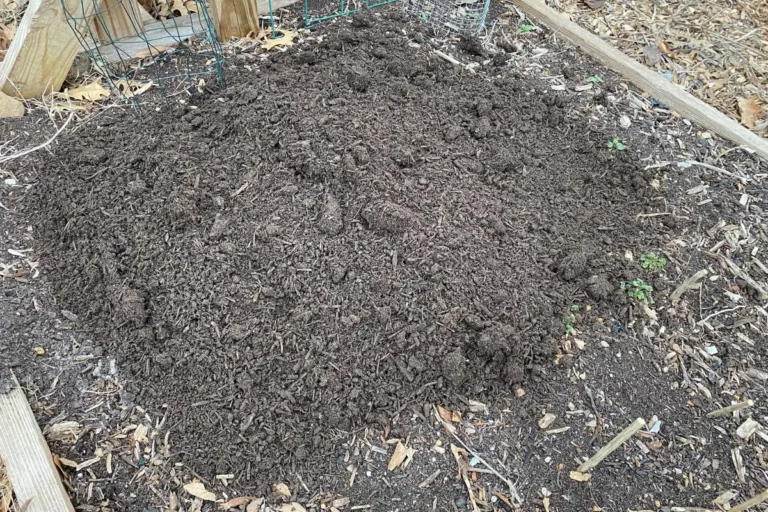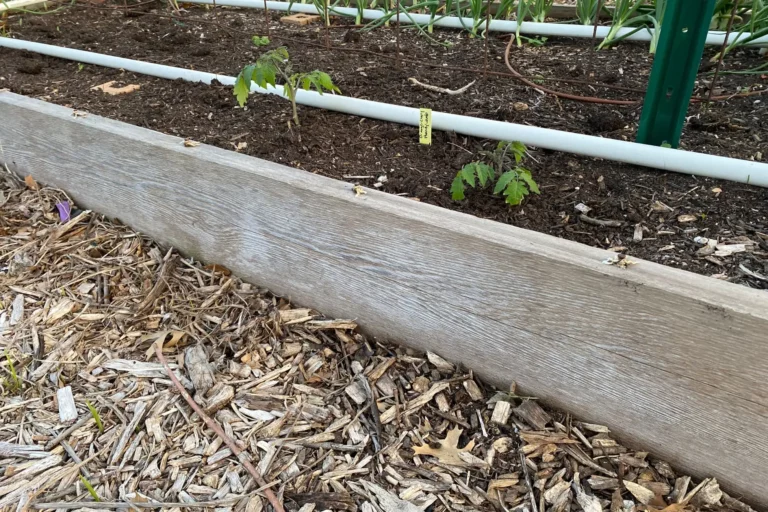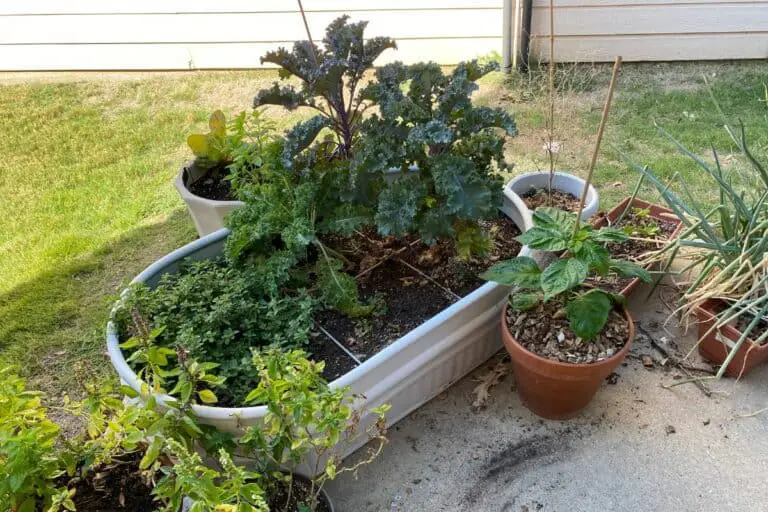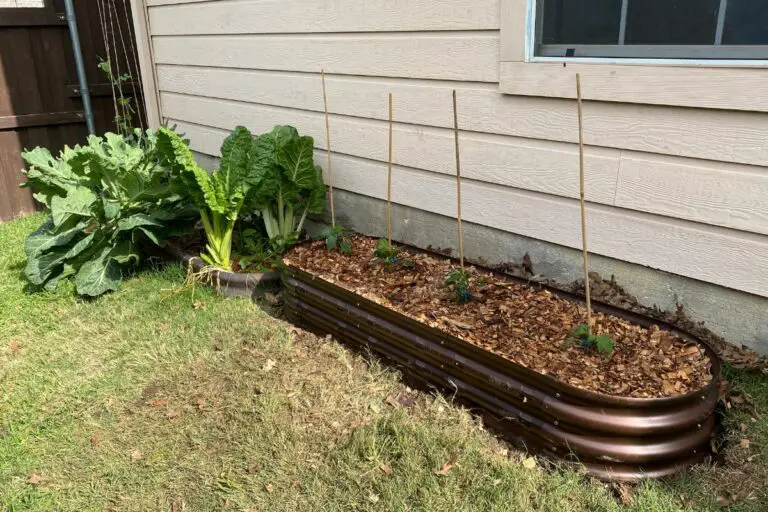12 Reasons Why Vegetables Can Grow Better in Raised Beds
Have you ever wondered if veggies would grow better in raised beds than in-ground beds or tilled soil?
Maybe you’ve experimented with different growing methods. Maybe you’re new to gardening (as I was years ago) and are trying to figure out what’ll help you grow the very best plants.
Either way, I’ve likely had the same thought you’re having right now: Will vegetables grow better in raised beds?
As a general rule, vegetable plants thrive in raised beds since the added soil imparts additional nutrients, ensures adequate drainage, and provides more room for root systems to grow and develop. But soil quality is key. If there’s poor soil in the raised beds, the plants will not grow any better.
What I’d like to do in this article is to provide an overview of the following:
- the reasons why veggies can often grow better in raised garden beds.
- several alternative growing methods that can produce great results.
- a list of plants that grow well in raised beds.
- several plants not to grow in raised beds because they’ll cause problems or headaches.
Over my 10+ years of gardening, I’ve made countless mistakes. My goal with this article is to share both what I’ve learned and the problems I’ve encountered along the way so that you can avoid some of the mistakes I made when I was just starting out.
If you’re interested in learning more about growing the very best veggies possible in raised beds, keep reading below!
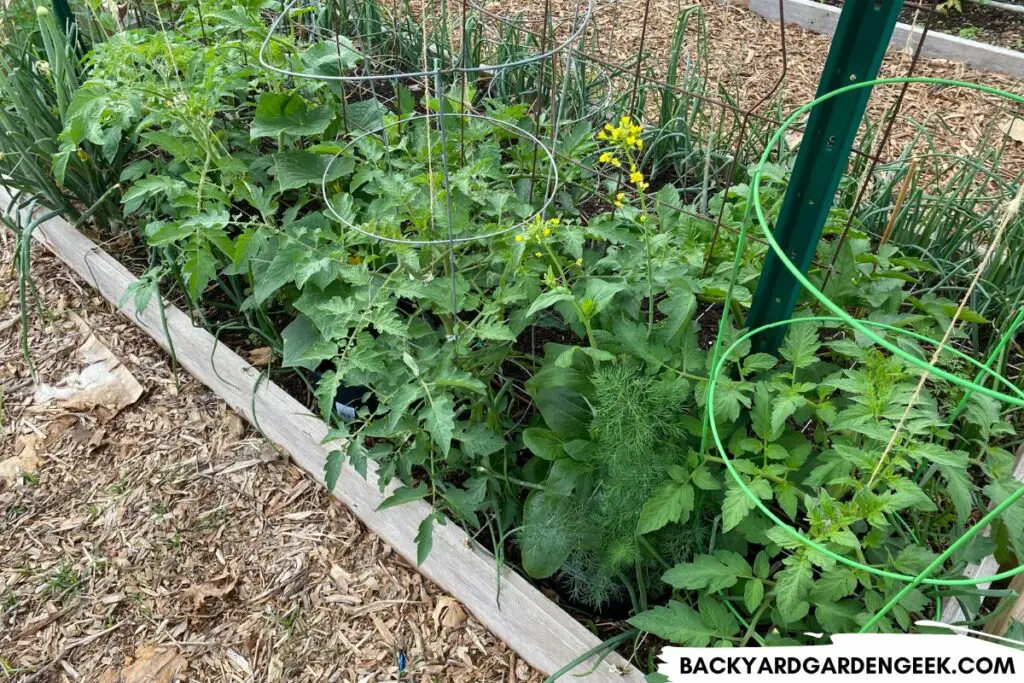
Can Vegetables Do Better in Raised Beds? 12 Reasons to Go For It
You can certainly grow vegetables successfully in an in-ground garden. I mean, humans have been doing it forever!
But there are several reasons why I prefer raised beds over in-ground beds.
There are also a few alternative methods that I’ve really come to like. I want to make sure you know all about them because if raised beds aren’t an option for you, you might consider these alternatives.
Here are 12 reasons why I prefer to grow vegetables in raised garden beds:
1. Raised Beds Increase Gardening Possibilities
Have you ever tried to garden on ground that’s very uneven or sloped?
Have you attempted to grow plants in ground that’s incredibly rocky or in soil that’s nothing but clay?
Or have you wished you could grow plants in areas that were covered in concrete or asphalt?
You clearly can’t garden atop concrete or asphalt surfaces, but if you try to put an in-ground garden on land that’s sloped or in an area where the soil is hard-packed clay or rocky, it’s just not going to work very well.
You can probably get some plants to grow, but the rain is going to wash away your soil, and the rocks are going to keep your plants from thriving.
I’ve got all 3 of these problems in my backyard.
My yard slopes in all directions, my soil is basically nothing but hard-packed clay, and my backyard has lots of concrete due to a detached garage and extended driveway that the previous owners installed.
I’d have basically no great places to garden in if I tried growing plants only in in-ground beds. Raised beds have allowed me to grow all kinds of vegetables…often more than my family can eat!
2. Raised Beds Allow for Hugelkultur
Given the terrible quality of my soil, I love the fact that raised beds allow me to practice a modified version of hugelkultur.
For those who’ve never heard of it, hugelkultur is an ancient gardening practice that essentially mimics what happens so often in nature.
Instead of tilling the ground, which is a relatively modern way to garden, those who gardened in ancient times would often build mounds.
They’d put down large things like logs, branches, and vines and cover them in smaller debris, then top everything off with grass, leaves, or other easily compostable materials.

Over time, all of these materials would start decomposing, and people would plant directly into the mounds. Those mounds were nutrient-rich, and they allowed people in areas with not-so-great soil to develop incredible gardening spaces.
You can do the same thing with raised beds.
I recently installed a 17-inch tall raised bed atop hard-packed clay soil in my backyard.
Instead of filling the entire bed with soil, which would’ve cost more money, I filled over half of it with material from a Christmas tree that my neighbor had thrown out on the street.
There are many materials you can put in the bottom of raised beds to create healthy soil, but I like to make sure that I have both brown materials such as logs, branches, and wood chips (for carbon) and green materials such as leaves, flowers, and kitchen scraps (for nitrogen). The Christmas tree was perfect for this!
I also added sticks and branches, grass clippings, kitchen scraps, leftover flowers, and other compostable materials. I then covered everything with 6 inches of garden soil (15 cm).
A year from now, that bed is going to be filled with amazing, nutrient-rich soil!
3. Raised Beds (Might) Have Better Soil
Because I’m able to control exactly what goes into my raised bed, I can make sure that the soil that’s in there is the best soil possible.
When I started gardening for the first time, I gave very little thought to the soil I was gardening in.
I remember going to Home Depot, buying a bunch of bags of garden soil, and dumping them into all of the containers I was using.
I had no clue what I was doing, but it was lots of fun!
But after that first year, I had to give more thought to the soil, because I wanted to reuse it year after year, not spend more money buying more and more soil.
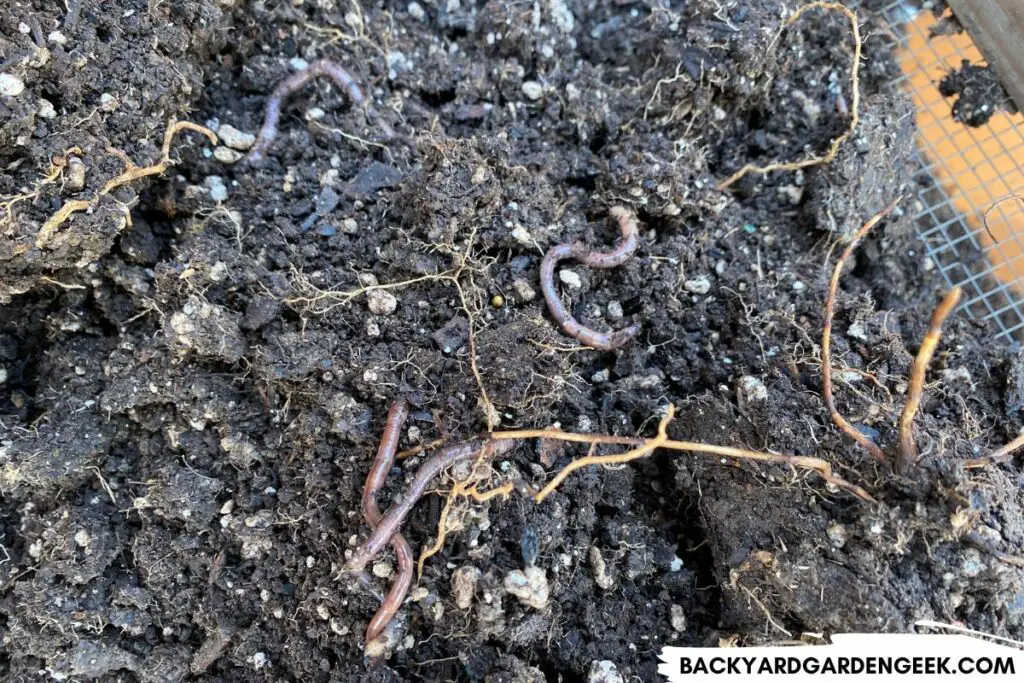
Whatever soil you’ve got on your property, your raised beds will allow you to do literally anything you might want to do to promote better soil and plant health.
I recommend hugelkultur because it’s a cheap and easy way to create wonderful soil for your garden.
4. Raised Beds Make It Easy to Do Soil Tests
But let’s say you’re unsure about the quality of your soil.
Maybe you’ve moved to a house that has some raised beds in the backyard already. Maybe you’ve just poured random bags of soil into your beds and hoped for the best. Maybe your plants didn’t do well last season.
Rest beds will make it easy for you to do a quick, simple soil test.
I don’t really recommend using the products you’ll find on Amazon or other online retailers.
Do this instead: Check out the website for your local agricultural extension office, then see if they have information posted about soil tests.
Here in Texas, it’s super simple to get your soil tested. You simply take a sample, then send it off to the Texas A&M extension office and wait a few weeks to get your results back.
In no time at all, you’ll have a detailed breakdown of your soil’s pH levels and overall health plus recommendations for how you can improve the soil.
How easy is that!
5. Raised Beds Make It Easy to Add Compost
Speaking of easy, I find that it’s incredibly simple to add compost to raised beds.
Not everyone has room in their backyards to create their own compost, but if you can, this will drastically improve the overall health of your garden.
You can also purchase good compost at a local garden center, but the stuff you make yourself is free!
Each season, I like to add several shovelfuls of compost to my raised beds, giving them a boost of nutrients a few weeks before I transplant my vegetable seedlings.
If the soil in your raised beds is looking rough these days, you can even remove some of the soil, then replace it with compost and mix things around well.
That’ll immediately help improve soil conditions for your vegetable plants.
6. Raised Beds Allow for Quick Mulching
One of the things I like about raised beds is how easy it is to top them with mulch.
Don’t underestimate the power of mulch. If you can get your hands on wood chips or even purchase bags of mulch from your local garden center, spread them over the top of your raised beds after you’ve planted your veggies.
The mulch will suppress any weeds that might try to grow. It’ll also help your soil with water retention and improve the overall health of your plants.
I did an experiment this past year. I installed 2 raised beds at the same time. In one bed, I covered the top with a thick layer of mulch. In the other bed, I didn’t.

I then planted tomato seedlings in both beds.
In 5-6 weeks, it was clear that the plants in the mulched raised bed were far outgrowing the plants in the bed without mulch.
Simply put, the simple addition of mulch improved plant growth by at least 30%, and raised beds made it easy for me to do so.
7. Raised Beds Improve Water Retention
As I just noted, mulch is important because your plants will do best in soil that’s neither too dry nor too wet.
My native soil is hard-packed clay, and it’s terrible for vegetable plants since water isn’t absorbed easily, and when it is, the clay retains it far too long.
By installing raised beds and by filling them with the very best materials, I was able to immediately improve the water retention in my garden. No more fighting that clay soil!
8. Raised Beds Drain Better
And now that we’re on the subject of water retention, let’s talk about drainage because water retention is terrible if the soil won’t let go of that water.
To install my rest beds, I dug up the grass underneath them so that I could get a fresh start.
When I did, the clay soil that I dug up was moist and sticky, like half-hardened glue.
Vegetable plants are not going to grow well in that kind of soil since it’s hard for the roots to expand and develop, and it’s difficult to water deeply since water either runs off the top of the soil or gets retained by the clay.
If you have raised beds, you won’t have any problems here.
Assuming you fill them with quality soil and make sure that they’re placed in areas that get plenty of sunlight, the water will drain from them just fine.
9. Raised Beds Help with Weeds and Grasses
If you’re interested in starting a garden, you’re going to have to fight against your region’s native weeds and grasses.
Your plants will too, and that’s never a good thing when it comes to healthy plant development.
Raised beds will help with this for a few reasons.
- First, you can kill off the weeds and grasses by placing thick layers of cardboard underneath.
- Second, you can surround your beds with wood chips to kill off grass that attempts to creep into your raised beds.
- Third, you can mulch the beds heavily to suppress any weed seeds. Just be sure to leave a few inches of space at the top so that you can add as thick a layer of mulch as possible.
10. Raised Beds Provide Space for Trellises
One of the things I love most about raised garden beds is the fact that they make it very easy to create trellises and other structures for vertical gardening.
If you’re like me and you don’t have a ton of space on your property, you’ll get the most from your harvest if you can grow plants vertically instead of along the ground.
If you’ve got wooden raised beds on your property, you can add structural support beams to each side of the raised bed, then create a trellis above the bed.
We’ve got such a system at the community garden where I do some of my gardening, and it works great.
The wood will warp over time, but you can string all kinds of plants from the ground to the wooden trellis above.
Cattle panel trellises are even better.
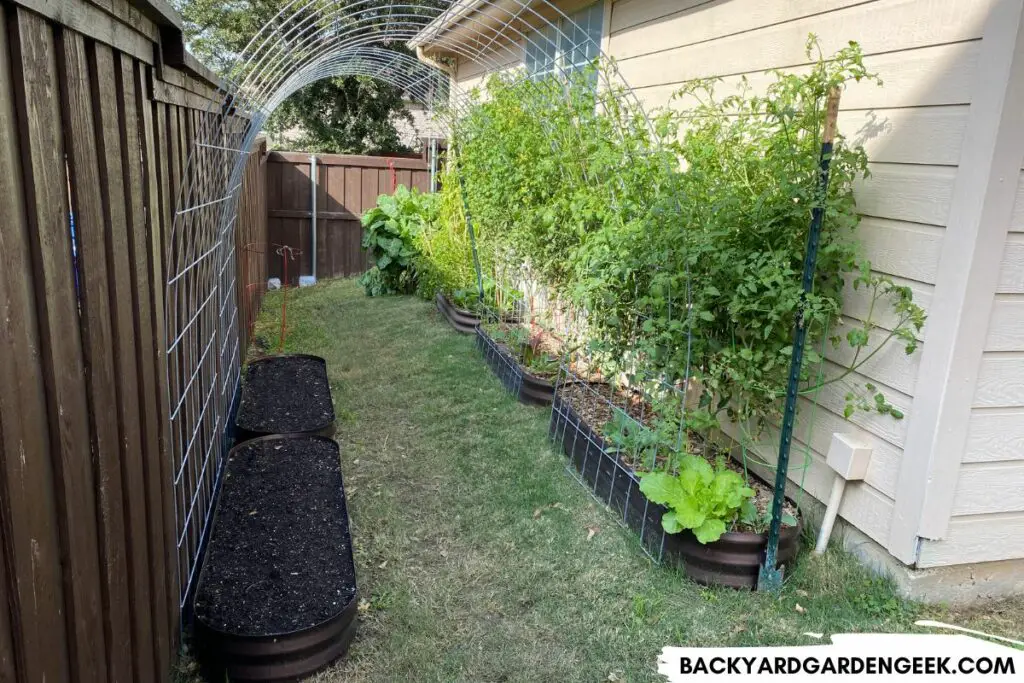
You can create arches with cattle panels that stretch from one raised bed to another. You can also hang cattle panels above a raised bed and provide additional support.
You can even attach cattle panels to posts and position the panels inside the raised bed, which is what I’ve got in my bed at the community garden.
In other words, once you’ve installed raised beds on your property, there are many, many ways to begin growing your plants vertically and increasing your overall harvest.
11. Raised Beds Are Better Than Containers or Grow Bags
When I first started gardening, I bought a bunch of paint buckets, drilled holes in the bottoms, and started growing plants in the buckets. I also used grow bags.
I did this because I was renting a house, and the only place I could garden was on an asphalt driveway.
Fast forward 10 years, and I’ve got a backyard I can garden in, but it’s not very big, and I’ve got a patio, so I’m trying to take advantage of that as well.
Whether you’re growing plants somewhere in your yard or growing plants on the patio, raised beds will provide the soil you need to maximize your harvest, regardless of the size of your property.
Drainage is also an issue when it comes to gardening in containers or grow bags. The total volume of soil is relatively low, so you’ve practically got to water every day during the summer.
And with grow bags, if you don’t water very, very slowly, you’ll lose water out of the sides since the bags are porous.
In fact, one of the ways to get around the watering problems with grow bags is to take 3-4 of them, put them in a kiddie pool, then fill the kiddie pool with several inches of water.
You’re essentially bottom-watering them to overcome the deficits of grow bag gardening.
But guess what’s better for your plants? Raised garden beds. If you’ve got the space, money, and time to do so, they’ll give you a much better harvest than buckets or grow bags ever will.
12. Raised Beds Make for Easier Harvesting
If you’ve ever experienced any kind of mobility issues, do you know how difficult it can be to garden when you’re even slightly incapacitated
I had knee surgery a few years ago, and I went through a fairly difficult period of recovery and rehab.
I could barely keep my garden growing during that time, and if it hadn’t been for my wife and kids, the plants would’ve likely died.
This is where raised beds are exceptionally handy. If you’ve got any kind of medical issues that makes kneeling or bending over tough to do, you might benefit from investing in raised beds, especially the larger versions that are sold by Birdies and Vego Garden.
But raised beds don’t just make gardening easier for those who’ve had medical issues. They make it easier for everyone!
This is definitely the case if you buy taller raised beds. I don’t own any 30-inch raised beds yet, but I’d love to buy some someday, because that would make gardening a snap.
Alternative Gardening Methods: 4 Easy Options
So what do you do if you don’t have raised beds and you don’t want to create an in-ground garden due to the poor overall quality of your soil?
The good news is that you’ve got several fantastic options for gardening, no matter what the soil is like on your property.
Option 1: Back to Eden (BTE) Gardening
Back to Eden gardening (also known as BTE gardening) is an option for anyone who’s got mediocre or poor soil but who wants to have an in-ground garden…and who’s also willing to be patient.
Pioneered by a man named Paul Gautschi, BTE gardening mimics nature in that it involves piling lots of organic materials on top of each other (typically trees that have been chopped into wood chips), then letting nature take its course.
As the materials slowly decompose, they’ll create layers and layers of rich soil, but this means that BTE gardeners have to get lots of wood chips. I mean piles and piles of it!
The goal with BTE gardening is to pile up wood chips 12-18 inches high (if not higher) so that the lower layers of wood chips turn into great soil. BTE gardeners then push aside the top layer of wood chips and plant plants directly in the lower layers.
What BTE gardening does is enrich the soil while making it less necessary to water as often since the decomposed wood chips are great at water retention. But it takes 1-3 years for the lower layers to decompose, so you’ll need to be patient at first.
Option 2: Grow Bags
If you don’t have much space or you need to garden atop concrete or asphalt, grow bags are a relatively cheap way to grow your own plants.
You can find them in all sizes, and when filled with good soil, they’ll give you added flexibility.
Last year, I grew broccoli, cauliflower, kohlrabi, lettuce, peppers, potatoes, and even tomatoes in mine.
The problem with grow bags is that the soil dries out fairly quickly during the hot summer months, and the bags will fall apart over time.
I lost 2 of them in the first year when their handles ripped off as I was moving the bags from one place to another.
If you want to make watering easier and have access to some of those cheap, plastic kiddie pools, put 3-4 grow bags in a kiddie pool, then fill the bottom with a few inches of water. The bags will wick the water up from the pool as needed so you don’t have to water them every single day.
Option 3: Paint Buckets
Paint buckets are another great option if you’ve got limited space on your property and can’t install raised beds.
You’ll need to drill holes in the bottom of each bucket, and you’ll want to make sure to buy tomato cages and some bamboo poles if you’re growing peppers or tomatoes in them, but when I first started gardening, I grew all kinds of veggies in mine.
If you really want to make the most of your growing space, use a 1- or 2-inch hole saw and cut large holes out of the bottom of your paint bucket (and maybe some 1-inch holes around the lowest part of the rim).
After this, cut a hole into some soil that’s roughly the diameter of the paint bucket and make sure it’s deep enough so that no holes are showing when you place the paint bucket in the hole.
Now that you’ve got your bucket in the hole, fill the bucket with high-quality soil and put a pepper or tomato plant in it.

Using this method, I grew a bumper crop of tomatoes in a part of my yard that had nothing but awful clay soil. In fact, my tomato plants grew so tall that I was able to create a tomato canopy.
When you do this, the plant’s roots not only fill up the bucket. They’re also able to access your native soil and pull whatever nutrients they can out of it.
Option 4: Terracotta Containers
If you’re going to be gardening on your patio, I recommend buying a water trough since that’ll mimic a raised garden bed.
But assuming you don’t have room or money in the budget for that sort of thing, the next best option are large terracotta pots.
Don’t buy the cheap plastic pots you’ll find at your local home improvement store. The soil in those pots will dry out super fast in the heat, whereas the soil in terracotta pots will stay moist longer because the pots retain water.
I’ve got a Tractor Supply water trough on my patio, and I love it. But I wanted to do even more gardening, so I placed several terracotta pots around it.
I like the overall look of the space, and I now have plenty of room for a nice herb garden.
What Vegetables Are Good to Grow in a Raised Bed?
The nice thing about raised beds is that you can grow all kinds of vegetables in them.
There are some veggies you should never plant in raised beds–which I’ll discuss in more detail below–but generally speaking, most vegetable plants thrive when planted in raised beds with nutrient-rich soil.
Here’s a list of vegetables that do well (or mostly well) in raised beds plus some thoughts about each:
| Artichoke | These are large, perennial plants. Only put them in a raised garden bed if you’re okay with them taking up space there for years to come. |
| Arugula | Easy to grow in raised beds! |
| Asparagus | You can certainly grow asparagus in raised beds, but you should only do so if you’re planning on giving that bed over to asparagus for many years. |
| Basil | Basil grows well in raised beds, and it’ll thrive in cinder block holes. It’ll even self-seed year after year. |
| Bean | If you’ve got a trellis in place, you can plant any beans, but if you’ve got no trellis available, you’ll need to stick with bush beans. |
| Beet | These will do just fine. Plant them using the square foot gardening method to get as many as possible into your bed. |
| Bok Choy | Plant in succession since these will go to seed as they get larger. |
| Broccoli | Great for raised beds, but they require a lot of space. Plant sparingly if you’re wanting to put other plants in your raised beds. |
| Broccoli Raab | Perfect for raised beds. |
| Brussels Sprouts | They’ll do great in raised beds, but they take a long time to mature, so they’ll take up space for many months. |
| Cabbage | Same as above. They grow well but take up space. |
| Cantaloupe | I’ve grown this in a raised bed, but you must grow vertically to make it worth it. |
| Carrot | These will do fine in raised beds, but they can be a little tricky to germinate sometimes. |
| Cauliflower | Much like cabbage, it’ll take up space, but cauliflower thrives in raised beds. |
| Celery | It’ll do just fine in raised beds. |
| Chives | Chives will do well in raised beds. |
| Cilantro | Once you get cilantro established, it’ll self-seed and come back year after year. |
| Collards | Collards will require 2-3 square feet to grow well, but I’ve had lots of success growing them in raised beds. |
| Corn | Keep corn out of raised beds. Corn needs to be planted in blocks or clusters to germinate properly. |
| Cucumber | You can grow cucumbers vertically in raised beds, but if you don’t have a trellis for them to grow up, I wouldn’t plant them there. |
| Dill | Easy to grow in raised beds. |
| Eggplant | Much like tomatoes, they’ll do just fine in raised beds, but they take up quite a bit of space, so plant them toward the edge of the bed so that its branches will hang out over the edge. |
| Escarole | This will do fine in raised beds. |
| Fennel | Fennel is a great addition to a raised bed. |
| Garlic | Garlic needs several months to mature, but you can grow it quite easily in raised beds. |
| Kale | This is a clear winner when it comes to raised beds. Mine have done incredibly well. |
| Kohlrabi | You can grow kohlrabi easily in raised beds. |
| Leek | Leek will do wonderfully in raised beds. |
| Lettuce | You can grow tons of lettuce in raised beds. Plant 4 per square foot. |
| Marjoram | This is an easy one to grow in raised beds. |
| Melon | Be careful with melons. The only way I’d grow them in a raised bed is if I planted them toward the edge, then let them expand into a nearby space. |
| Mustard | Mustard will do well in raised beds. |
| New Zealand Spinach | You can plant this in raised beds. |
| Okra | I’ve grown okra in raised beds as well as concrete block holes, but the plants can get very tall. You’ll need a step stool to harvest the pods if it grows too well. |
| Onion | I like to plant onions around the edge of my raised bed. |
| Oregano | Easy to grow in a raised bed. |
| Parsley | Much like cilantro, it’ll thrive in raised beds. |
| Parsnip | Parsnips will do just fine if spaced properly. |
| Pea | Like pole beans, you shouldn’t grow peas in raised beds unless you’ve got a support system in place for them to grow upward. |
| Pepper | I’ve grown many pepper plants in raised beds. They love it! |
| Potato | Raised beds are perfect for potatoes since the soil is loose, which is what potato tubers need to develop properly. |
| Radicchio | Radicchio will do well in raised beds. |
| Radish | Radishes will too. |
| Rhubarb | I’ve never grown rhubarb, but as far as I can tell, it’ll do just fine in a raised bed. |
| Rutabaga | Rutabagas are perfectly suited for raised beds. |
| Rosemary | You can easily grow rosemary in a raised bed, but I tend to grow mine in my flower beds so as to save the raised bed for other veggies. |
| Rue | Rue does best with good drainage, so raised beds are a plus. |
| Sage | This plant is a good addition to a raised bed. |
| Shallot | Much like onions, shallots will grow well in raised beds. |
| Sorrel | Sorrel is a relatively compact plant that’ll do well in a raised bed. |
| Spinach | Be sure to succession plant your spinach. They’ll do great in raised beds, but you need lots of plants to ensure ongoing harvests. |
| Squash (summer) | Summer squash thrives in raised beds. I’ve grown quite a few over the years! |
| Squash (winter) | Keep winter squash out of your raised beds. It needs lots of room to grow. |
| Strawberry | These will do just fine in raised beds. |
| Swiss Chard | I grew this in my raised beds last year. It didn’t take up too much space and handled winter weather pretty well. |
| Tarragon | It’ll grow just fine in raised beds. |
| Tomatillo | These will grow well in raised beds. Just give them the proper support. |
| Tomato | Be careful with tomatoes. You can grow dwarf and micro-dwarf varieties just fine in raised beds, quite a few determinate varieties as well. Don’t grow indeterminate varieties unless you have a trellis of some kind to support them. |
| Thyme | Like most herbs, this is well-suited for raised bed gardening. |
| Turnip | Turnips will do fine in raised beds. |
| Sage | This is perfectly suitable for a raised bed. |
| Sweet Potato | You can grow sweet potatoes in raised beds, but you’ll need to give the vine somewhere to grow, preferably up a trellis or spilling outside the bed. |
| Watercress | This plant isn’t suitable for a raised bed, but you can grow it in a container. |
| Watermelon | Keep it out of a raised bed. It needs much more room to grow. |
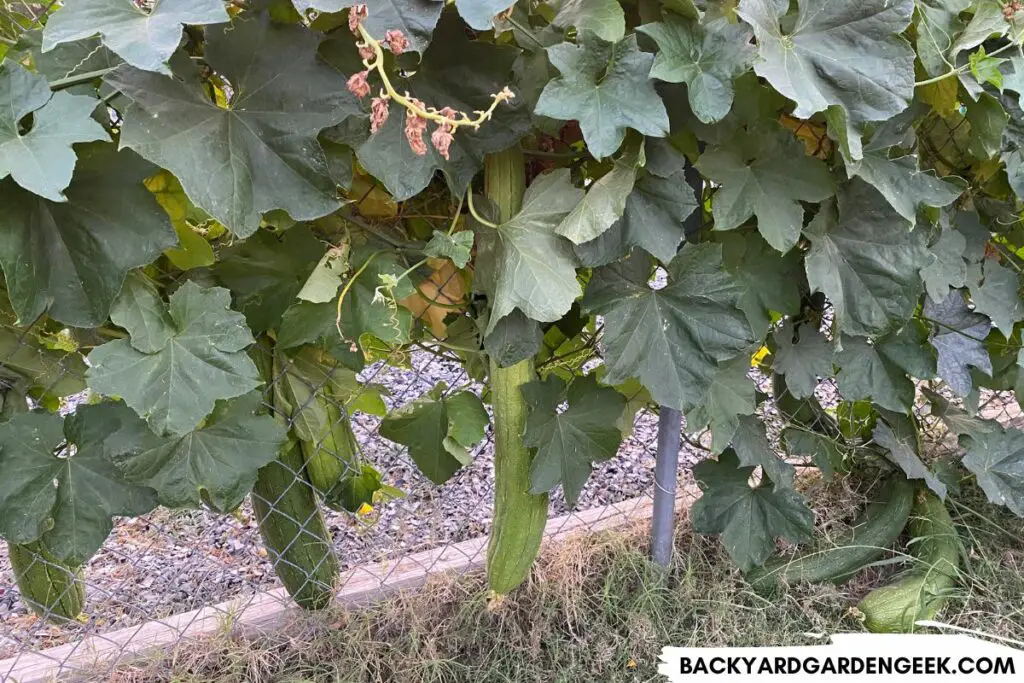
What Vegetables Should Not Be Grown in a Raised Bed?
When it comes to growing vegetables in raised beds, you can grow practically everything, but that doesn’t mean you should.
In fact, there are many plants you should never grow in raised beds plus a few others that you’ll want to consider carefully before planting.
You can read my article about plants you shouldn’t grow in raised beds for all of the details, but here’s a quick list in case you’d like to glance at them:
- Barley
- Bee Balm
- Blackberries
- Blueberries
- Bottle Gourd Squash
- Comfrey
- Corn
- Hops
- Lemon Balm
- Luffa
- Malabar Spinach
- Millet
- Mint
- Oats
- Pumpkin
- Raspberries
- Rice
- Sorghum
- Tansy
- Tromboncino Squash
- Watercress
- Watermelon
- Wheat
- Winter Squash
- Yarrow
Long story short, if you plan to grow these plants, I recommend keeping them out of your raised beds or, at the very least, thoughtfully considering how best to grow them among your other plants.
Want to Learn More?
If you want to learn more about raised bed gardening, check out these related articles. You’ll find out about what I’ve learned over the years as well as the mistakes you should avoid when installing raised beds and growing plants in them.

